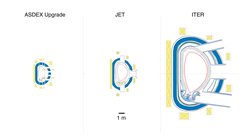Topical research

Third deuterium-tritium campaign in 2021
In 2021, after the deuterium-tritium campaigns in 1991 and 1997, plasma experiments that generate fusion energy are again planned at JET. IPP scientists have contributed intensively to the preparations. More >>
JET with an ITER-like wall
In 2011 JET has begun a new era – after a nearly two-years shutdown for the installation of the ITER-like wall with beryllium and tungsten tiles. For 26 years JET hads been a predominantly carbon-walled machine. Now it is a new device with the same wall materials as ITER. JET will be progressively brought up to full power to allow a proper investigation of the ITER materials under conditions approaching those of ITER.
IPP was involved in development of the method for cladding the wall tiles of the new JET wall. On the GLADIS thermal-flux test rig at IPP the thermo-mechanical behaviour of these highly loaded components was investigated and serial production of the tungsten-clad tiles was accompanied by quality-ensuring tests. In addition, the load limits of the tungsten cladding were ascertained in order to define the maximum tolerable wall load during JET operation. IPP also produced for JET components for characterising the ITER-like wall, viz. deposition monitors and wall inserts for investigations of erosion and deposition processes, and developed and built new plasma diagnostics.

JET and ASDEX Upgrade
With this change to a carbon-free environment JET took a step, which ASDEX Upgrade had already taken, that is linking the programs of these two machines even more strongly.
IPP participates in the JET project by delegating scientific and technical personnel. Furthermore, physicists and engineers from IPP are also involved in defining and realising upgrades of the JET device. Again, the objective is to achieve better predictions of ITER's performance.
In 2019, about 20 IPP scientists were ivolved in JET actvities.

